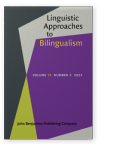Vol. 13:3 (2023) ► pp.343–371
Who did what to whom, and what did we already know?
Word order and information structure in heritage and L2 Russian
This paper reports on an experimental investigation of what second language (L2) learners and heritage speakers of Russian know about the relationship between word order and information structure in Russian. The participants completed a bimodal acceptability judgment task, rating the acceptability of SVO and OVS word orders in narrow-focus contexts, under neutral prosody. Heritage speakers behaved like the control group of baseline speakers, preferring SVO order in answer to object questions, and OVS order in answer to subject questions. In contrast, L2 learners preferred SVO order regardless of the context. While the heritage speaker group was more proficient than the L2 group, proficiency alone cannot account for differences in performance: specifically, with regard to acceptance of OVS order for subject narrow focus, heritage speakers improved with proficiency, but L2 learners did not. It is proposed that heritage speakers have an advantage in this domain due to early age of acquisition (cf. Montrul, 2008). This finding is consistent with prior literature on narrow focus with heritage speakers of other languages, and suggests that this phenomenon is not particularly vulnerable in heritage languages.
Article outline
- 1.Introduction
- 2.Background and study motivation
- 2.1Russian word order
- 2.1.1Information structure, word order and prosody
- 2.1.2Word order and IS in child Russian and Ukrainian
- 2.1.3Word order and IS in adult learner and heritage Russian
- 2.2Narrow focus in HS and L2 populations
- 2.2.1Narrow focus realization with HSs and L2ers of other languages
- 2.2.2Narrow focus, transfer, and HS advantages
- 2.3Research questions
- 2.1Russian word order
- 3.Methodology
- 3.1Participants
- 3.2Proficiency tests
- 3.2.1Proficiency cloze test
- 3.2.2Case check test
- 3.3Bimodal AJT
- 3.3.1Materials
- 3.3.2Prosodic properties of target items
- 4.Results
- 4.1Cloze test and case check tests
- 4.2Bimodal AJT results
- 4.2.1Analysis 1: Three-group comparison
- 4.2.2Analysis 2: Proficiency effects
- 5.Discussion
- 6.Conclusion
- Acknowledgements
- Notes
-
References
